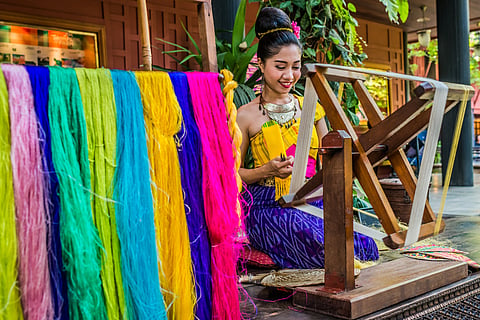
- Destinations
- Experiences
- Stay
- What's new
- Celebrating People
- Responsible Tourism
- CampaignsCampaigns
- SubscribeSubscribe
- Buy Now

Thailand’s silk and cotton industries are famed for their unique designs due to their hand-woven nature. Thai silk in particular shines with a lustre that will change colours depending on the angle of light. While Thai residents don’t often wear silk in their day-to-day life due to the climate, cotton, which is far more comfortable, breathable and durable, is ubiquitous. The adaptability of Thai cotton makes it suited for a wide range of garments, from casual wear to traditional attire.
Here are some of the country’s inimitable textile patterns which you should bring back from your Thailand tour.
Silk ikat or mat mii (มัดหมี่) is a dyeing process where the patterns on the finished cloth are dyed onto the weft threads before weaving. Weavers string the silk across a frame that is the width of the finished fabric. Plastic ribbons or banana plant skins are tied around each individual thread in the desired design, after which the silk is dipped in the dye. The banana skin and ribbons resist the immersion and the process is repeated several times to make the designs more and more intricate.
Therefore, mat mii weaving is a traditional craft that requires advanced skills. Common motifs are inspired from the living world such as the heads of snakes, flowers, birds and leaves. The technique has long been practised in the northeastern province of Isan.
Mo hom (หม้อห้อม) is a traditional Thai fabric created by soaking the cloth in a vat of the indigo plant. Making the dye is a laborious process and requires a three to four day investment of harvesting, soaking, fermenting, oxidising, filtering, collecting the indigo sludge, preparing the vat and finally, dyeing.
The town of Ban Thung Hong in Phrae province is reviving mo hom. Their gorgeous and stylish pieces are a must-have in your wardrobe.
This textile is regarded as one of the most prestigious in the country. The term pha mai yok dok (ผ้าไหมยกดอก) means to have the floral pattern delicately weaved so that it slightly pops out from the fabric. Brocade-style is the ancient technique of weaving gold and silver threads into the pattern, which gives pha mai yok dok its luxurious look. The weaving technique has been passed down for generations among its practitioners and the material is a firm favourite of the royal family.
Lamphun town has made this textile their own and become an important centre of pha mai yok dok silk weaving.
Khit (ขิด) is a form of brocade which means "to raise" or "to pick." The warp threads are selectively lifted by special khit sticks or by hand to allow the shuttle through to create the desired design and pattern, usually in the form of a diamond. A painstaking and intricate technique, the weaving of khit requires extraordinary skill and patience.
Garments and materials made in this style can be purchased from local businesses in Udon Thani province.
Called "The Queen of Thai Silk" due to its intricate patterns, vibrant colours, shinning texture and beauty, phrae wa is a shoulder cloth of elaborately patterned silk brocade anywhere from 2m in length to 45cm in width. It is exclusively woven by women of the Phu Thai ethnic community.
The heart of phrae wa weaving is centered in the village of Ban Phon in Sakon Nakhon province. The artisans' weaving expertise has been handed down from mother to daughter through generations. The cloth holds a significant cultural value and is often worn on special occasions.
